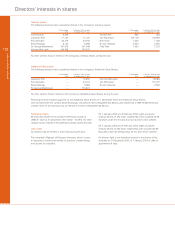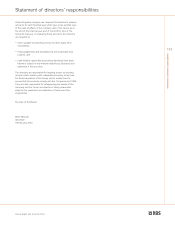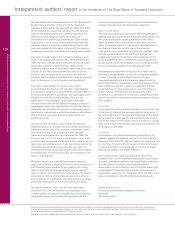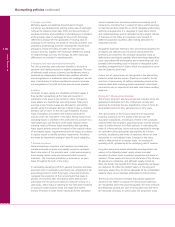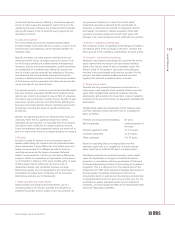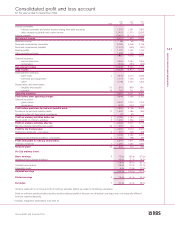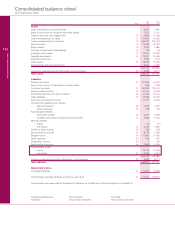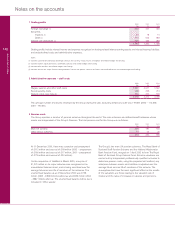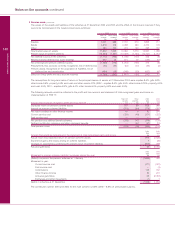RBS 2003 Annual Report Download - page 140
Download and view the complete annual report
Please find page 140 of the 2003 RBS annual report below. You can navigate through the pages in the report by either clicking on the pages listed below, or by using the keyword search tool below to find specific information within the annual report.
138
4 Foreign currencies
Monetary assets and liabilities denominated in foreign
currencies are translated into sterling at the rates of exchange
ruling at the balance sheet date. Profit and loss accounts of
overseas branches and subsidiary undertakings are translated
at the average rates of exchange for the period. Exchange
differences arising from the application of closing rates of
exchange to the opening net assets of overseas branches and
subsidiary undertakings and from restating their results from
average to period-end rates are taken to profit and loss
account reserves, together with exchange differences arising
on related foreign currency borrowings. All other exchange
differences are included in operating profit.
5 Pensions and other post-retirement benefits
The Group provides post-retirement benefits in the form of
pensions and healthcare plans to eligible employees. The cost
of defined benefit pension schemes and healthcare plans is
assessed by independent professionally qualified actuaries
and recognised on a systematic basis over employees’ service
lives. Contributions to defined contribution pension schemes
are recognised in the profit and loss account when payable.
6 Leases
Contracts to lease assets are classified as finance leases if
they transfer substantially all the risks and rewards of
ownership of the asset to the customer. Other contracts to
lease assets are classified as operating leases. Total gross
earnings under finance leases are allocated to accounting
periods using the actuarial after tax method to give a constant
periodic rate of return on the net cash investment. Finance
lease receivables are stated in the balance sheet at the
amount of the net investment in the lease. Rental income from
operating leases is credited to the profit and loss account on a
receivable basis over the term of the lease. Balance sheet
carrying values of finance lease receivables and operating
lease assets include amounts in respect of the residual values
of the leased assets. Unguaranteed residual values are subject
to regular review to identify potential impairments. Provisions
are made for impairment arising on specific asset categories.
7 General insurance
General insurance comprises short-duration contracts and
include principally property and liability insurance contracts.
Due to the nature of the products sold – retail based property
and casualty, motor, home and personal health insurance
contracts – the insurance protection is provided on an even
basis throughout the term of the policy.
In calculating operating profit from general insurance activities,
premiums (net of reinsurance premiums) are recognised in the
accounting period in which they begin. Unearned premiums
represent the proportion of the net premiums that relate to
periods of insurance after the balance sheet date and are
calculated over the period of exposure under the policy, on a
daily basis, 24th’s basis or allowing for the estimated incidence
of exposure under policies which are longer than twelve
months. Provision is made where necessary for the estimated
amount required over and above unearned premiums net of
reinsurance, including that in respect of future written business
on discontinued lines under the run-off of delegated underwriting
authority arrangements. It is designed to meet future claims
and related expenses and is calculated across related classes
of business on the basis of a separate carry forward of
deferred acquisition expenses after making allowance for
investment income.
Acquisition expenses relating to new and renewed business for
all classes are deferred over the period during which the
premiums are unearned. The principal acquisition costs so
deferred are commissions payable, direct advertising expenditure,
costs associated with the telesales and underwriting staff and
prepaid claims handling costs in respect of delegated claims
handling arrangements for claims which are expected to occur
after the balance sheet date.
Claims (net of reinsurance) are recognised in the accounting
period in which the loss occurs. Provision is made for the full
cost (net of reinsurance) of settling outstanding claims at the
balance sheet date, including claims estimated to have been
incurred but not yet reported at that date, and claims handling
expenses.
8 Long-term life assurance business
The Group’s long-term assurance business includes whole-life,
guaranteed renewable term life, endowment, annuity and
universal life contracts that are expected to remain in force for
an extended period of time, generally five to forty years.
The value placed on the Group’s long-term life assurance
business comprises the net assets of the Group’s life
assurance subsidiaries, including its interest in the surpluses
retained within the long-term assurance funds, and the present
value of profits inherent in in-force policies. In calculating the
value of in-force policies, future surpluses expected to emerge
are estimated using appropriate assumptions as to future
mortality, persistency and levels of expenses, which are then
discounted at a risk-adjusted rate. Changes in this value,
which is determined on a post-tax basis, are included in
operating profit, grossed up at the underlying rate of taxation.
Long-term assurance assets attributable to policyholders are
valued on the following bases: equity shares and debt
securities at market price; investment properties and loans at
valuation. These assets are held in the life funds of the Group’s
life assurance companies, and although legally owned by
them, the Group only benefits from these assets when surpluses
are declared. To reflect the distinct nature of the long-term
assurance assets, they are shown separately on the consolidated
balance sheet, as are liabilities attributable to policyholders.
The Group has reinsured contracts that transfer significant
insurance risk. Within net assets, the reinsurance cash flows
are recognised when they become payable. For most contracts
this effectively spreads the cost of reinsurance over the life of
the reinsured contracts. In some cases, the acquisition costs
Accounting policies
Accounting policies continued






